November 4, 2019. Trip Oversight
Top 12 Trip Picks
• Pyramids of Giza
• Parthenon – Athens, Greece
• Meteora, Greece (Kalabaka)
• Plitvice Lakes National Park, Croatia
• West Cork, Ireland
• Banks of the Seine, Paris, France
• London along the Thames
• Luxor, Egypt
• Dublin, Ireland
• Peloponnese, Greece
• Dubrovnik/Trogir/Zadar, Croatia
• Cappadocia, Turkey
BC Really Stood for Before Coffee
Seven months on the road and countless sites seen, cities lived in (temporarily), countries visited, and cultures experienced leave you with countless memories. The experiences fill you with fresh opinions, unexpected thrills, new friendships, and real-life exposure to images and places we’ve dreamed about our entire lives, and twice as many more that we never expected. It also leaves you with a yearning to see more. Ellen and I were on the road for 213 days, eight countries (not counting Iceland, or Bosnia-Herzegovina), we slept in 51 different beds, visited 22 UNESCO World Heritage sites, and explored who knows how many towns and cities.
But we’ve also got a list of the things we’ve seen, and places we really enjoyed. Friends continually ask what we enjoyed the most on our journey. That’s tough to decide, or rank from first to last. That’s like asking “What’s your favorite food.” or “Who is your favorite child?”, give me a break. Our trip experience was cumulative, and difficult to separate the experience into discrete events. Much of what we did or saw built upon the events of the previous day or week, and blended over our travels to paint our memories. Here are a few of our favorite memories from our travels in 2019. You may have heard of these places before, but here’s a list of experiences we’d do again. Today I’ll review, Peloponnese, Greece.
Lovin the Life in the Peloponnese
If you like citrus fruit, the Peloponnese is for you. There are oranges and lemons everywhere. Literally. Everyone has a dozen trees in their yard and every square foot of the countryside either has an orange tree or olive tree planted on it. Harvest time is January and February. This place is Florida without alligators, South Beach and Donald Trump playing golf at Mar-a-Lago.
There are so many places to visit when in the Peloponnese, so here is a list of sights worth seeing:
• Palamidi Fortress
• Tiryns
• Mycenae
• Sanctuary of Asklepios at Epidaurus
• Olympia
• The Fortress at Argos
• Seaside village of Astros
• Nafplion Archeological Museum
• Mystras & Sparti
• Dendra Cemetary and Midea Castle
Palamidi Fortress
Perched up on the hill over Nafplion are the remains of an old fort. Its walls snaked all over the 700 feet high hill, and was built by the Venetians between 1711 until 1714. As soon as they finished it, it was captured by the Turks in 1715 and they kept it until 1822, which really pissed off the locals because if they didn’t like the Venetians the found the Turks a whole lot worse.
Tiryns (UNESCO site)
Tiryns was a major Mycenaean citadel around 1400 to 1200 BCE (that is 3,400 years ago, which is pretty damn amazing), its located in Argolis, literally around the corner from our apartment in Aria (4 kms, if that far). It’s only 1.5km from the port, so back then it controlled the trade routes between the mainland and the Aegean cities.
The area was inhabited before the Bronze age (over 5,000 years ago), and ancient Greeks believed that the citadel was built by Proitos, brother of the king of Argos, Akrisios, and grandfather of Perseus (can you think Clash of the Titans?), the founder of Mycenae. Up close, the stones in the walls of this fortress were about as large as a Ford F150. They were huge. So large, in fact that the legend goes that they were built by cyclopes (yes, the big dudes with only one eye). The funny thing is, they give the history of these archeological sites as if they really were built by cyclopes or that Perseus did fight the Titans (or that cyclopes and Titans did exist).
Mycenae (UNESCO site)
This is an Mycenaean archaeological site near Mykines about 15 miles from our apartment. It sits high on a hill rising up about 900 feet (275 meters) above the sea level giving it a commanding view of the beautiful olive grove-filled valley. To generate some contemporary significance for this fort, let me tell you a historically wonky story. Way back in the 1600 BCE time, it was one of the major centers of Greek civilization, and a military stronghold. This place was supposedly founded by that Titan-killer Perseus though the date is not quite certain.
After Perseus and all his family were wiped out in the various wars that were always going back and forth back then, the legend has it that a future ruler of Mycenae Atreus had two sons, Agamemnon and Menelaus (12th century BCE) who would inherit Mycenae.
The next country over, King Tyndareus of Sparta had two daughters, Helen (does that name sound familiar?) and Clytemnestra (which is not a STD), whom Menelaus and Agamemnon married, respectively. Agamemnon inherited Mycenae and Menelaus became king of Sparta. Soon, Helen eloped with Paris of Troy. And all the fun begins. We plan on visiting ancient Troy the next time we visit Turkey.
Sanctuary of Asklepios at Epidaurus (UNESCO site)
Needing new classical challenges, Ellen and I drove up the road about half an hour to the Sanctuary of Asklepios at Epidaurus (or Asclepius). Epidaurus in legend was the birthplace of Apollo‘s son Asclepiusthe healer, it’s known for its sanctuary situated about five miles (8 km) outside the town with its amazing open air amphitheater, which is still in use today.
This place is stunning. Not only did we spent hours wandering around and looking at all the artifacts (the pictures I took don’t do justice to this place or the surrounding valley), we also came back another day, never entering the ruin, just to hike the countryside, with it’s amazing vistas. The ruin, which I hadn’t heard of, was a Mycenaean sanctuary dedicated to a healing god stands on the Kynortion hill, northeast of an ancient theater about 15 kilometers from our apartment. Asclepius is the ancient Greek god of medicine. The rod of Asclepius, a snake-entwined staff, remains still the symbol of medicine today. It was founded in the sixteenth century BCE over the remains of a settlement of the Early and Middle Bronze Age (2800-1800 BCE) settlements, and functioned until the eleventh century BCE. Unlike other sanctuaries of this period, it was really, really big, it covers much of the valley and hillside. You can’t see this site in one hour and hop back on the bus.
This archeological site is where I want a second home. The surrounding mountains are beautiful and it is incredibly serene and peaceful. This is a site you can’t miss in the Peloponnese.
Olympia (UNESCO site)
About 3 hours west of Aria is Olympia, probably the most renowned archeological sites in all the Peloponnese. I don’t know who would ever could come down to the peninsula without going to see this ruin It did not disappoint us. If you didn’t know, this is the site of the very first Olympic Games. The archaeological ruins holds over 70 significant buildings, and the remnants of many of these structures survive (to some degree), although the main Temple of Zeus exists only as stones on the ground. The site is a major tourist attraction, and has two museums (one focused on the excavation efforts of the site) and the other on artifacts found during the excavation, which Ellen and I thought were more significant than either of the museums at the Acropolis or Delphi.
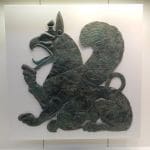
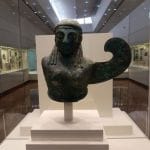
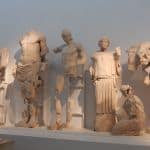
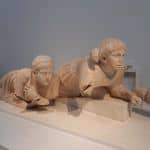
The Olympic stadium was huge and I’m sure was the Jerry’s World (Dallas Cowboys stadium in Texas) of the day. The original Olympic Games were founded in the 8th century BCE. Around the stadium extensive ruins include athletic training areas, the palace of Nero (yup, the “Rome is burning” Emperor), Roman bath houses (they must have been a very clean bunch of people), and various houses for artists, politicians, priests, and even slave quarters. It also housed the Archaeological Museum of Olympia with exhibit finds from the site, including a statue of Hermes attributed to the sculptor Praxiteles that is the star attraction of the museum.
Nafplion Archeological Museum
There are dozens of archeological sites within 20 kilometers of Nafplion. A great deal of the artifacts are housed at the Nafplion Archeological Museum. Which is a very old, farm stone, two-story building on the north end of Syntagma Square in old town Nafplion. Even if you aren’t going to the museum, this is where you want to be on a lazy, sunny afternoon, drinking wine on a sidewalk café in old town. Nafplion was a Venetian town for about 200 years. They built the Palamidi Fortress overhead, and the town’s architecture is all Venetian as it was built during a very prosperous period for the city until it fell to old King Otto in 1715.
The museum building was constructed in 1713, during the second reign of the Venetians, under the Naval Proveditore Augustine Sagredo to be used as the navy’s depository, I couldn’t find when it became the museum. It is well-preserved, quirky, not ADA-compliant, and a very interesting Venetian structure.
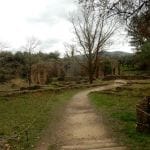
Nafplion was inhabited way back to the Mycenaean period (1600-1100BC) and up till the present day, although there have been times that the city was largely deserted. The town was known as Napoli di Romania in Venetian times and even today it still feels like an Italian village. It was the first capital of Greece after the war of independence against the Turks in 1821. It was also where the first president of Greece, Johannis Kapodístrias, was murdered in 1831.
The ship-shaped island in the mouth of the harbor is the castle of Bourtzi. The Venetians completed its fortification in 1473 to protect the city from pirates and nasty ship-hosted frat parties. In 1822 it was captured by Greek troops and served as a fortress until 1865. It was then transformed into residence of the executioners of convicts from the castle of Palamidi. This would be like living in a stone condo during February in Minneapolis. I really do like the Venetian style architecture. Its off season, they only take tours to the island on Saturdays and Sundays, so we never seemed to make it downtown on these days to take the tour.
Mystras & Sparti
The best part of staying in a small village like Aria is the ability to jump in your rental and leave town for a day trip. Down the peninsula, Mystras is a fortified town in Laconia, Peloponnese. Situated on Mt. Taygetos, near ancient Sparta, it served as the capital of the Byzantine Morea in the 14th and 15th centuries. Much of the later era it was under Ottoman control, and of course the Greeks didn’t like that. In the 1830s, it was burned and abandoned and the new town of Sparti was built approximately eight kilometers to the east.
This place is stunning. Close your eyes and think of the Greece in your mind’s eye (not the Acropolis or Santorini…..you tourist) and the hills and olive-covered plains around Sparti is what you imagine. We drove up for a quick view. We pulled into Sparti before aiming the car up the steep, narrow road into Mystras. Our biggest mistake was not leaving the apartment in Nafplion at the crack of dawn as there is much more to see in Mystras than we had time, but it was a very scenic drive and we enjoyed the day none-the-less. Though it’s February, once again Greece has spoiled us with perfect weather for our ride.
To get a feel for this area, you need to understand its history and that goes back to pre-historic times. Man has lived here for a long, long time. Long before bronze was a common metal mastered by metal workers. But the ruins that remain are almost all from the medieval times. It was ruled by the Francs, the Byzantines, the Nicaeans, the Venetians (twice), Ottomans, and finally the Greeks.
Mystras was burned and abandoned under King Otto in the 1830s for the newly built town of Sparti. In 1989 the ruins, including the fortress, palace, churches, and monasteries, were named a UNESCO World Heritage Site.
Dendra Cemetary
What do you like to do when visiting a foreign country? Well, we like to look at graveyards. Well, not always…..but, sometimes they are so damned interesting. Included in that group is the ancient Mycean burial ground of Dendra. Dendra is a prehistoric (and historic) archaeological site situated outside the village with the same name belonging to the municipality of Midea, Greece which was about 7 kilometers East of our apartment in Nafplion.
The site usage stretches back at least to the early Bronze Age and is significant for the period since archaeologist Axel W. Persson uncovered an unplundered tholos tomb and many Mycenaean chamber tombs, belonging to the Mycaen rulers, movers and shakers from the nearby citadel of Midea. A tholos tomb (or domed tomb), is a grave built with an underground dome (much like an igloo construct). The structure looks much like a beehive, so the traditional English name.
Midea Citadel
So, where did all those dead nobles buried in Dendra come from? Probably Midea, since its only about 2 kilometers up the road on a hill. In fact, Tiryns is only 4 kilometers away, and Mycenae is about 10 kilometers off in the other direction. This was the center of the Mycenean empire, and home to Agamemnon and all those Greek Troy-busters. (Though Achilles was originally from Myrmidons, part of Thessaly, which is north of Athens close to Thessaloniki). So how he got mixed up with these Myceneans, I have no idea.
The Midea citadel was built atop a hill, which reaches 270 meters above sea level and 170 meters above the surrounding area (very high, but not on a Colorado scale); it was a helluva long way up there and the road was awful for our visit in 2019, so I can imagine it was like in 1200 BC; the citadel dominates the eastern edge of the rich farming valley and is located about half way between Mycenae and Tiryns. We got lost on the way to the citadel, so its not that easy to find, but it was well worth it when we got there. Again, like at Dendra, we were the only visitors to the castle, and there was no entry fee to get in. We liked the price, but sites such as this deserve more attention.
How long should you stay: A week to a lifetime.
Where to stay: There are a lot of options at very good prices. We preferred renting an apartment, but there are lots of hotels worth checking out. I’d recommend staying in the towns of Nafplion, Sparti, Monemvasia, Astros, or one of the cozy beach-side towns.
What to see: See above, there is so much history and ancient artifacts, beautiful hiking trails, and even some fabulous beaches if that’s your thing.
Next Up: Dalmation Coast, Dubrovnik/Trogir/Zadar, Croatia



























































































































































































